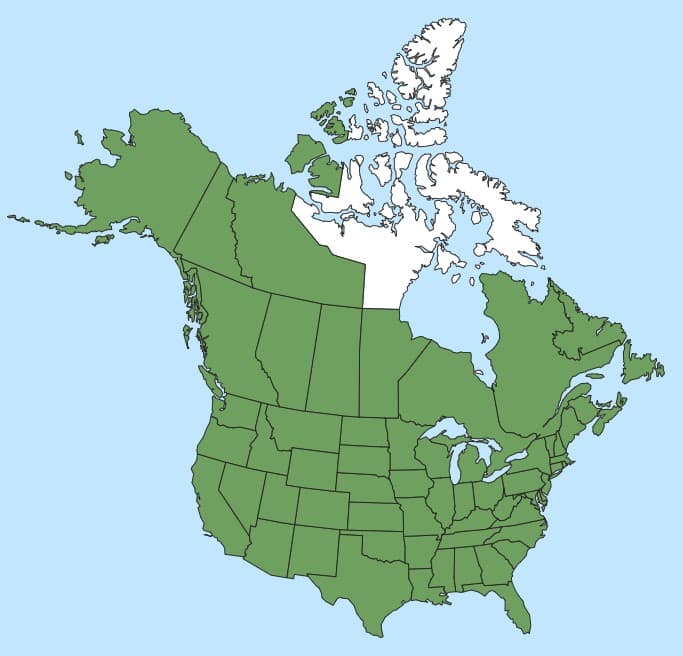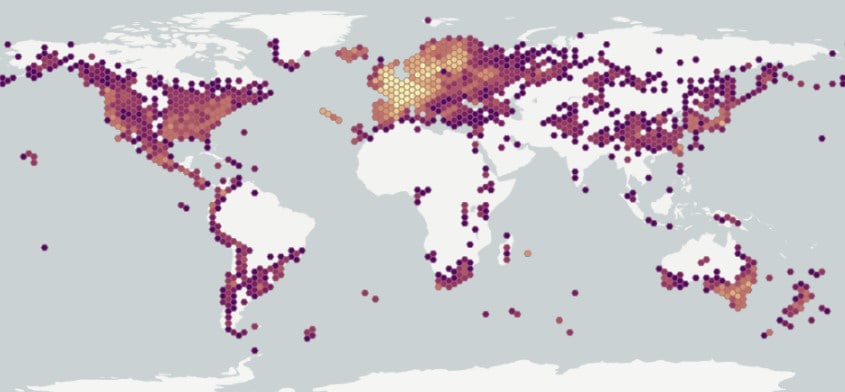Poa annua
Explore More :
Explore plus :
Overview
Aperçu
Regulation :
Remarques Réglementation:
- USA Federal Noxious Weed Seed List
Regulation Notes:
Poa annua is classified as a noxious weed seed in at least sixteen states within the United States and in the District of Columbia (USDA-AMS 2022b).
Poa annua is on the Panama and the Republic of Korea lists of harmful organisms (USDA-PCIT-PExD 2022) (*may be updated without notice).
Distribution :
Répartition :
Poa annua is native to the temperate regions of Eurasia but has been naturalized and become widely spread to temperate and subtropical regions all over the world, and it is the only non-native flowering plant species that has been able to establish a breeding population in the maritime Antarctic (Mitich 1998; Molina-Montenegro et al. 2019; CABI 2022; USDA-ARS 2022).
Habitat and Crop Association :
Habitat et Cultures Associées :
Poa annua is common in agriculture and in grasslands from lowland to mountain pastures. This species adapts well to a wide variety of soil types, and is tolerant to trampling, mowing, and frozen conditions (CABI 2022). It is a common weed in turf, lawns, bowling greens, golf courses, pastures, agronomic and horticultural crops, lake and river margins, along road and rail lines, pavement cracks, and disturbed sites in coastal, mesic and wet forests (Mitich 1998; PIER 2017; CABI 2022). P. annua is listed as a weed in 38 crops in more than 80 countries within and outside its native distribution range (CABI 2022). It is frequently found in crops such as Avena sativa (oats), Beta vulgaris subsp. vulgaris (sugar beet), Brassica napus (oilseed rape), Hordeum vulgare (barley), Medicago sativa (lucerne), Oryza sativa (rice), Solanum tuberosum (potato), and Zea mays (maize) and in orchards (Holm et al. 1997).
Economic Use, cultivation area, and Weed Association :
Utilisation économique, zone de culture et association de mauvaises herbes :
Although recognized as a weed in many places worldwide and in some cases as a noxious or harmful weed, Poa annua is recognized as crop species in the Canadian Methods and Procedures for Seed Testing, the AOSA Rules for Testing Seeds, the ISTA Rules for Seed Testing, and the USDA Federal Seed Act (CFIA 2023; AOSA 2022; ISTA 2022; USDA-FSA 2022).
When grown in monoculture, Poa annua is used for golf course putting greens because it is more tolerant of low-light environments and is more foot traffic tolerant than Agrostis stolonifera var. palustris (creeping bentgrass), a common grass species used for putting greens (Mitich 1998; Nicoludis 2021).
Duration of Life Cycle :
Durée du cycle vital:
Annual or short-lived perennial (e.g., P. annua var. reptans) (Mitich 1998; DiTomaso and Healy 2007).
Dispersal Unit Type :
Type d’unité de dispersion :
Floret and caryopsis
General Information
RENSEIGNEMENTS GÉNÉRAUX
Poa annua is an annual or short-lived perennial tufted grass native to temperate regions of Eurasia. This species is a highly adaptable cool-season grass with growth habits that suit a wide variety of environmental conditions. Even when mowed to a height of 0.5 cm plants are capable of producing hundreds of seeds (Mitich 1998). When purposefully planted, plant growth regulators are used to prevent seed production under short mowing conditions of golf course putting greens (Nicoludis 2021).
Outside its native range P. annua has become a weed that does not displace other plants but is rather an opportunistic colonizer (Mitich 1998) and has become one of the most widespread weeds on earth (Barkworth et al. 2007). It can be a difficult weed to control as it is a prolific seed producer. Each plant can produce anywhere from 1050-2250 seeds, which can lie dormant for more than 30 years under certain field conditions (DiTomaso and Healy 2007; CABI 2022). Human activity like mowing, movement of soil, transport of contaminated lawn seed mixtures, as well as water movement, consumption and deposition by animals, and wind currents are the main forms of seed dispersal (Mitich 1998).
.Identification
Identification
-
Spikelet
Size
- Spikelet length: 3 – 6 mm (Edgar and Connor 2000; Barkworth et al. 2007; eFloras 2022).
Spikelet size from literature:
• Spikelet length: 3 – 5 mm; laterally compressed; 2 – 6 florets (Barkworth et al. 2007).
• Spikelet length: 4 – 6 mm; 3 – 6 florets (Edgar and Connor 2000).
• Spikelet length: (3) 4 – 5.5 mm; 3 – 5 florets (eFloras 2022).Shape
- Spikelet egg-shaped to oblong, laterally compressed (Barkworth et al. 2007; eFloras 2022).
Surface Texture
- Surface texture of glumes papery and smooth.
Colour
- Spikelet colour light yellowish brown.
Other Features
Spikelet composition
- Spikelet composed of 2 – 6 similar looking florets (Barkworth et al. 2007).
Glumes
- Lower glume length: 1.5 – 2 (3), 1-nerved; upper glume length: 2 – 3 (4) mm, 3-nerved (eFloras 2022).
Disarticulation
- Spikelet disarticulation generally occurs above glumes and between florets at the rachilla nodes.
-
Floret
Size
- Floret length*: 1.4 – 3.4 mm (average 2.5 mm); width*: 0.5 – 0.9 mm (average 0.7mm); thickness*: 0.5 – 0.9 mm (average 0.8 mm).
*Note: minimum and maximum size based 30 florets in normal range of this species using image measurement protocol (ISMA 2020). Length equals longest measurement of floret, width equals greatest measurement of floret in palea view, thickness equals greatest measurement of floret in lateral view. Measurements by Meyer: CDA-S-24801, CDA-S-24803, CDA-S-24808.
- Floret length**: 2.4 – 3.1 mm (average 2.7 mm); width**: 0.6 – 0.8 mm (average 0.7 mm)
**Note: Minimum and maximum of 10 florets in a normal range of this species using image measurement protocol (ISMA 2020). Measurements by CFIA staff.
Size measurements from literature:
• Lemma length: 3 – 3.5 mm; rachilla length: 0.5 – 1 mm (Edgar and Connor 2000).
• Lemma length: 2.5 – 4 mm (Barkworth et al. 2007).
• Floret length: 3 – 3.5 mm; width 0.9 – 1.1 mm (Bojňanský and Fargašová 2007).
• Lemma length: 2.2 – 3.5 mm; rachilla length: 0.5 – 1.5 mm (eFloras 2022).Shape
- Floret narrowly teardrop shaped (lanceolate), laterally compressed, keeled along back of lemma.
Surface Texture
- Lemma and palea thin and papery.
Colour
- Florets brownish-yellow coloured, generally dull but translucent along upper lemma margins to tip.
Other Features
Lemma
- Lemma strongly keeled and prominently 5-nerved.
- Lemma nerves usually densely hairy in lower half.
- Area between lemma nerves without hairs.
- Lemma tip blunt or tapered to a point, may be folded inward or flared out, extending well beyond the palea tip.
- Lemma loosely enclosing caryopsis.
Awn
- Lemma without awn.
Callus
- Callus blunt, without hairs.
Rachilla
- Rachilla cylindrical, up to one-third the length of the floret, smooth and without hairs.
Palea
- Palea noticeably shorter than lemma.
- Palea is membranous between keels.
- Palea keels usually with long, dense hairs along lower two-thirds of keels and without hairs in upper one-third of keels.
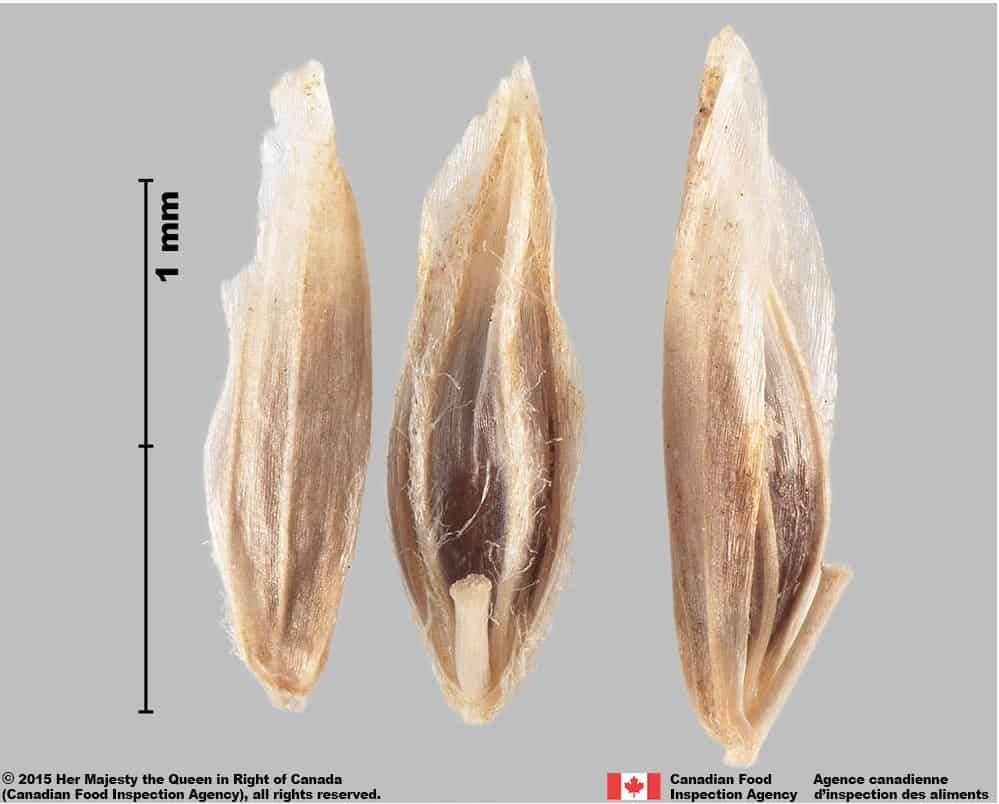
Annual bluegrass (Poa annua) florets

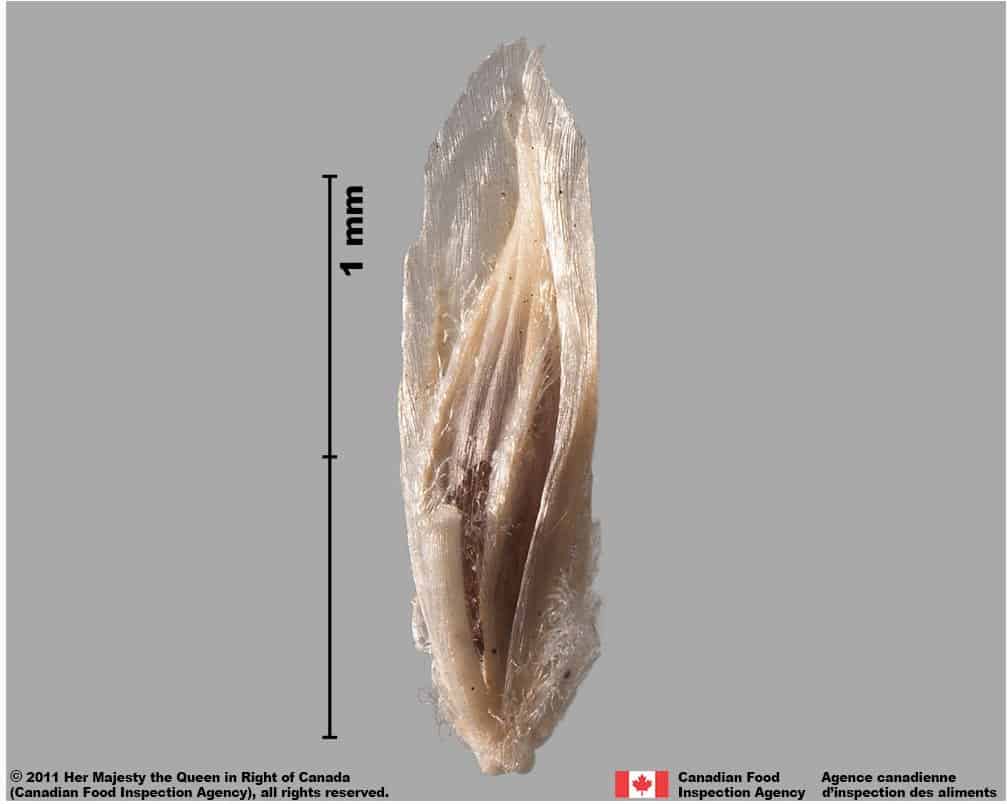
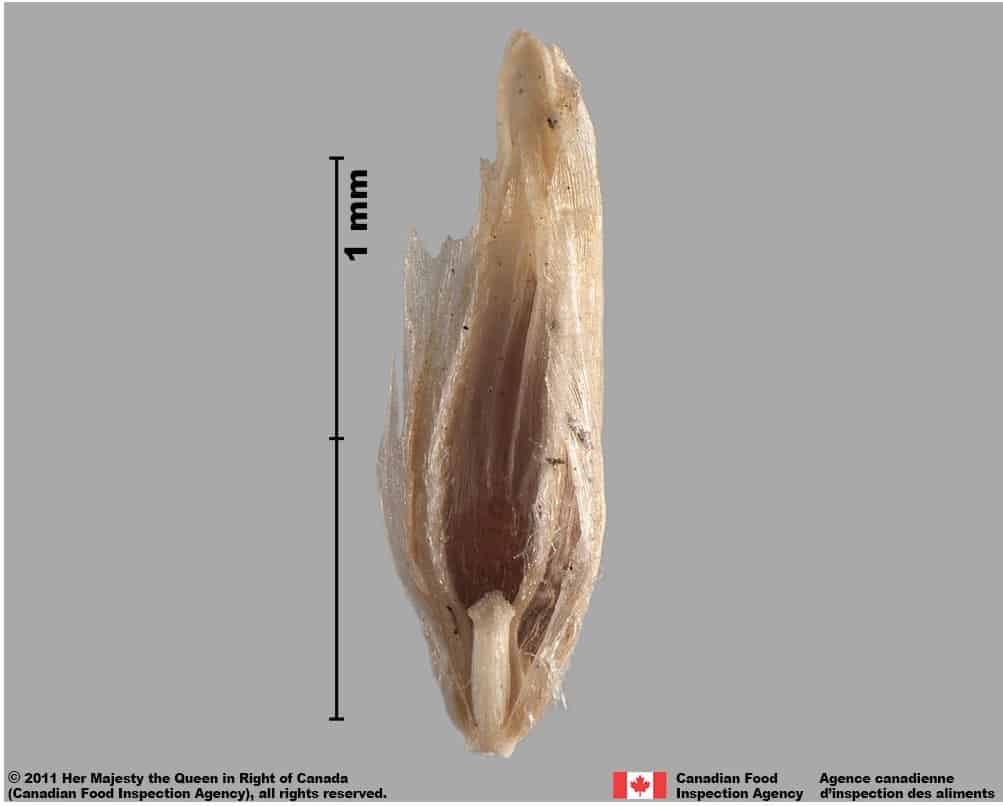
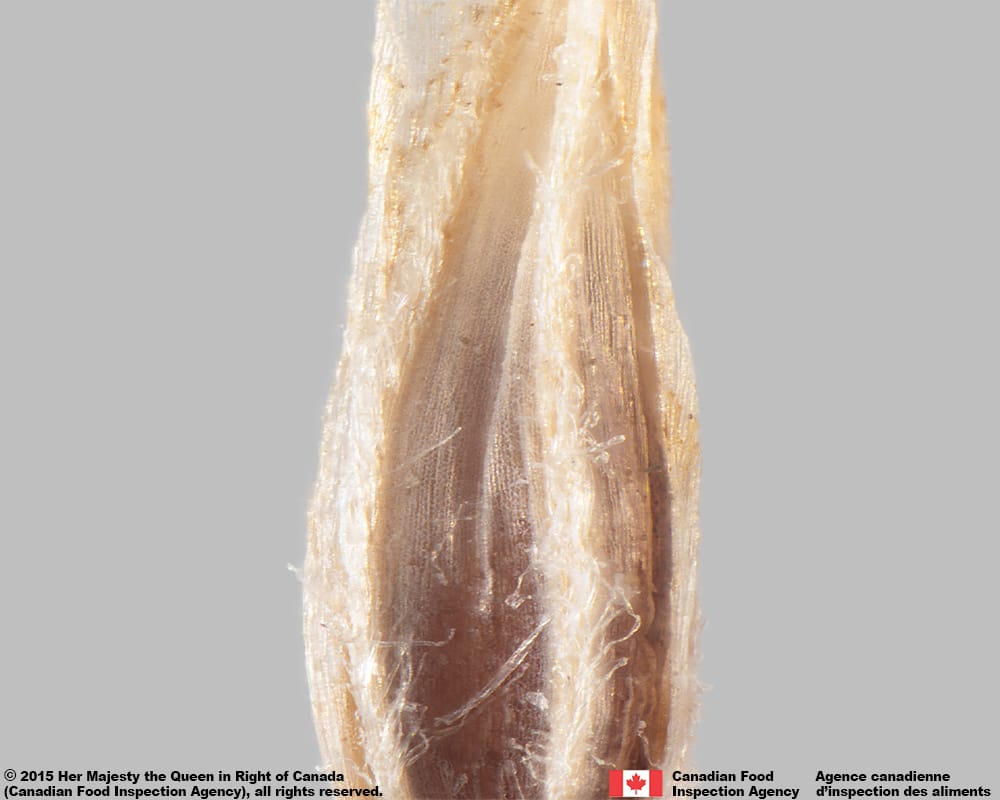
-
Caryopsis
Size
- Caryopsis length*: 1.3 – 1.6 mm (average 1.4 mm); width*: 0.5 – 0.7 mm (average 0.6 mm); thickness*: 0.5 – 0.7 mm (average 0.6 mm).
- Hilum length*: 0.06 – 0.09 mm (0.08 average mm).
*Measurement notes: minimum and maximum size based 10 caryopses in normal range of this species using image measurement protocol (ISMA 2020). Length equals longest measurement of caryopsis, width equals greatest measurement of caryopsis in embryo view, thickness equals greatest measurement of caryopsis in lateral view. CDA-S-24803.
Caryopsis size measurements from the literature:
• Caryopsis length: 2.1 – 2.3 mm; width 0.7 – 0.8 mm wide (Bojňanský and Fargašová 2007).Shape
- Caryopsis broadly egg-shaped, slightly compressed laterally.
Surface Texture
- Caryopsis faintly striate.
Colour
- Caryopsis reddish brown coloured.
Other Features
- Hilum a small round spot located near base of caryopsis on the side opposite the embryo.
-
Embryo
Size
- Embryo length 0.3 – 0.5 mm (average 0.4 mm).
- Embryo about one-quarter the length of caryopsis.
*Note: minimum and maximum size based 10 embryos in normal range of this species using image measurement protocol (ISMA 2020). CDA-S-24803.
Shape
- Embryo oval.
Endosperm
- Endosperm solid (Terrell 1971).
Other Features
- Embryo position lateral (Martin 1946).
Identification Tips
CONSEILS POUR L’IDENTIFICATION
Several characters are key to separating Poa annua and other species of Poa. These include:
- Lateral lemma nerves prominent.
- Lemma keel, marginal, and lateral nerves with long silky hairs on lower half.
- The palea appears like a bulging belly when floret is in lateral view.
- Palea keel hairs long and densely spaced, present in lower three-fourths of keels, usually absent in upper one-fourth.
- Caryopsis loosely enclosed by the lemma and palea.
- Surface of caryopsis with a slightly raised, net-like reticulation.
- Embryo protruding from the caryopsis surface appears beak-like.
- No hairs on the callus.

Annual bluegrass (Poa annua) floret, palea view




Additional Botany Information
AUTRES RENSEIGNEMENTS BOTANIQUES
Flowers/Inflorescence
- Panicles 1 – 10 cm long, upright, loosely pyramid shaped, nodes with 1 – 2 (5) branches (Barkworth et al. 2007; DiTomaso and Healy 2007).
Vegetative Features
- Plants are densely tufted and non-rhizomatous, although they can sometimes be stoloniferous or root at the lower nodes to form mats in the short-lived perennial, as in P. annua var. reptans (Barkworth et al. 2007; DiTomaso and Healy 2007).
- Stems 2 – 20 (45) cm tall (Barkworth et al. 2007).
Similar Species
ESPÈCES SEMBLABLES
Similar species are based on a study of seed morphology of various species, and those with similar dispersal units are identified. The study is limited by physical specimen and literature availability at the time of examination, and possibly impacted by the subjectivity of the authors based on their knowledge and experience. Providing similar species information for seed identification is to make users aware of similarities that could possibly result in misidentification.
Florets of Poa annua are similar looking to those of P. supina (supine bluegrass) a species sold commercially in the turf industry, and P. alpina (alpine bluegrass) a native perennial, that is a fairly common circumboreal forest species of subalpine to arctic habitats in the northern hemisphere (Barkworth et al. 2007; KEW 2023) and marketed for erosion control, reclamation, and environmental restoration (Alderson and Sharp 1995).
Poa alpina L., alpine bluegrass (Wiersema and León 1999)
Floret size generally larger than P. annua, floret length 2.8 – 3.9 mm (average 3.4 mm); width 0.7 – 1.2 mm (average 1.0 mm).** Lemma nerves faint; palea as long as lemma; palea keels with soft hairs for nearly entire length, hairs shorter neat palea tip; rachilla 0.5 – 0.8 mm (Barkworth et al. 2007), smooth or sparsely hairy; caryopsis size generally larger than P. annua, caryopsis length 2.1 – 2.3 mm, width 0.7 – 0.8 mm (Bojňanský and Fargašová 2007). Poa alpina has two subspecies; P. alpina subsp. alpina is the more common of the two and reproduces via fertile florets, whereas in P. alpina subsp. vivpara (L.) Arcang. the spikelets are all bulbiferous (bulbil forming), or some plants produce both normal and bulbiferous spikelets (Barkworth et al. 2007).
Poa supina Schrad., supine bluegrass (Alderson and Sharp 1995)
Floret size similar to P. annua, floret length 2.2 – 3.2 mm (average 2.7 mm); width 0.7 – 0.9 mm (average 0.8 mm).** Lemma margins transparent, nerves faint, distinct to three-fourths the length, not distinct near lemma tip; palea length nearly equal to lemma, space between palea keels wider and more opaque than in P. annua, keels usually glabrous or sometimes sparsely hairy; rachilla cylindrical, less than half the length of the floret, smooth and without hairs; caryopsis length 1.2 – 1.4 mm, width 0.7 – 0.7 mm (Bojňanský and Fargašová 2007).
**Note: minimum and maximum size based 10 florets in normal range of this species using image measurement protocol (ISMA 2020). Data provided by CFIA staff.
Please refer to the comparison table for P. annua, P. supina, and P. alpina for comparison of diagnostic features.
Comparison of diagnostic features of unmilled florets of Poa annua, P. supina, and P. alpina
| Poa annua | Poa supina | Poa alpina | |
| Floret length*/** | 1.4 – 3.4 mm (average 2.5 mm)*
2.4 – 3.1 mm (average 2.7 mm)** |
2.2 – 3.2 mm (average 2.7 mm)** | 2.8 – 3.9 mm (average 3.4 mm)** |
| Floret width*/** | 0.5 – 0.9 mm (average 0.7 mm)*
0.6 – 0.8 mm (average 0.7 mm)** |
0.7 – 0.9 mm (average 0.8 mm)** | 0.7 – 1.2 mm (average 1.0 mm)** |
| Lemma | – Lemma tip folded inward or flared, wrinkled
– Lemma margins and tip translucent – Nerves distinct to the lemma tip – Lemma keel, marginal and lateral nerves usually with long soft hairs – Area between nerves hairless |
– Lemma tip flared open
– Upper margin and tip translucent – Nerves faint, distinct in lower three-fourths of lemma, not distinct in upper one-fourth – Lemma keel and marginal nerves sparsely short hairy to near tip – Area between nerves hairless |
– Lemma tip flared
– Nerves faint – Lemma keel and marginal nerves short to long hairy – Area between nerves sparsely to moderately short hairy |
| Palea | – Noticeably shorter than lemma
– More translucent and space between keels tends to be narrower than in P. supina – In lateral view the palea appears like a bulging belly |
– Nearly the same length as lemma
– More opaque than P. annua – Space between keels tends to be further apart wider than in P. annua |
– Nearly the same length as lemma |
| Rachilla | – Smooth and without hairs | – Smooth and without hairs | – Smooth or sparsely hairy |
| Caryopsis | – Length 1.3 -1.6 mm (average 1.4 mm), width 0.5 – 0.7 mm (0.6 mm)*
– Length 2.1 – 2.3 mm, width 0.9 – 1.1 mm (Bojňanský and Fargašová 2007) |
– Length 1.2 – 1.4 mm, width 0.6 – 0.7 mm (Bojňanský and Fargašová 2007) | – Length 2.1 – 2.3 mm, width 0.7 – 0.8 mm (Bojňanský and Fargašová 2007) |
*Note: minimum and maximum size based 30 florets (from three herbarium specimens) and 10 caryopses in normal range of this species using image measurement protocol (ISMA 2020). Measurements by D. J. L. Meyer.
**Note: minimum and maximum size based 10 florets in normal range of this species using image measurement protocol (ISMA 2020). Data provided by CFIA staff.
When not sold commercially as a crop kind, Poa annua can be found as contaminant in seed lots of P. pratensis (Kentucky bluegrass), P. compressa (Canada bluegrass), P. trivialis (rough bluegrass), or other types of lawn, turf, and pasture grass seed lots. Please refer to individual factsheets for these species for contrasting features.
Comparison table of unmilled florets of Poa annua, P. pratensis, P. compressa, and P. trivialis.
| P. annua | P. pratensis | P. compressa | P. trivialis | |
| Floret shape | In lateral view the palea appears like a bulging belly.
Lemma tip folded inward or flared out. |
Lemma keeled, keel straight to slightly curved.
Lemma apex folded inward. |
Lemma and palea usually flared open at tip. | Lemma sharply keeled; keel curved.
Lemma tip folded inward. |
| Lemma | Papery with membranous margins. | Papery | Papery | Papery, appearing oil soaked. |
| Lemma veins and keel | Lateral nerves prominent. Keel, marginal and lateral nerves with long silky hairs in the lower half. | Lateral nerves prominent, usually without hairs.
Lower two-thirds of keel and marginal nerves with long soft hairs.
|
Lateral nerves obscure or lacking.
Lower two-thirds of keel and marginal nerves with long soft hairs.
|
Marginal and lateral nerves and keel prominent, without hairs. |
| Palea keel hairs | Long, densely spaced, and not extending to tip of palea | Short, coarse, wide-spaced, and not extending to tip of palea | Short, fine, close-spaced, and extending to tip of palea | Short, fine, close-spaced, and extending to tip of palea |
| Caryopsis | Embryo pinched and beak-like.
Surface with fine-net-like texture. Caryopsis loosely enclosed by lemma and palea. |
Caryopsis spindle shaped, loosely enclosed by lemma and palea. |
Caryopsis spindle shaped, loosely enclosed by lemma and palea. | Caryopsis spindle shaped, tightly enclosed by lemma and palea. |
| Callus hairs | None | Long & web-like | Short & web-like | Long & web-like |
Click to select species
Cliquez pour sélectionner les espèces
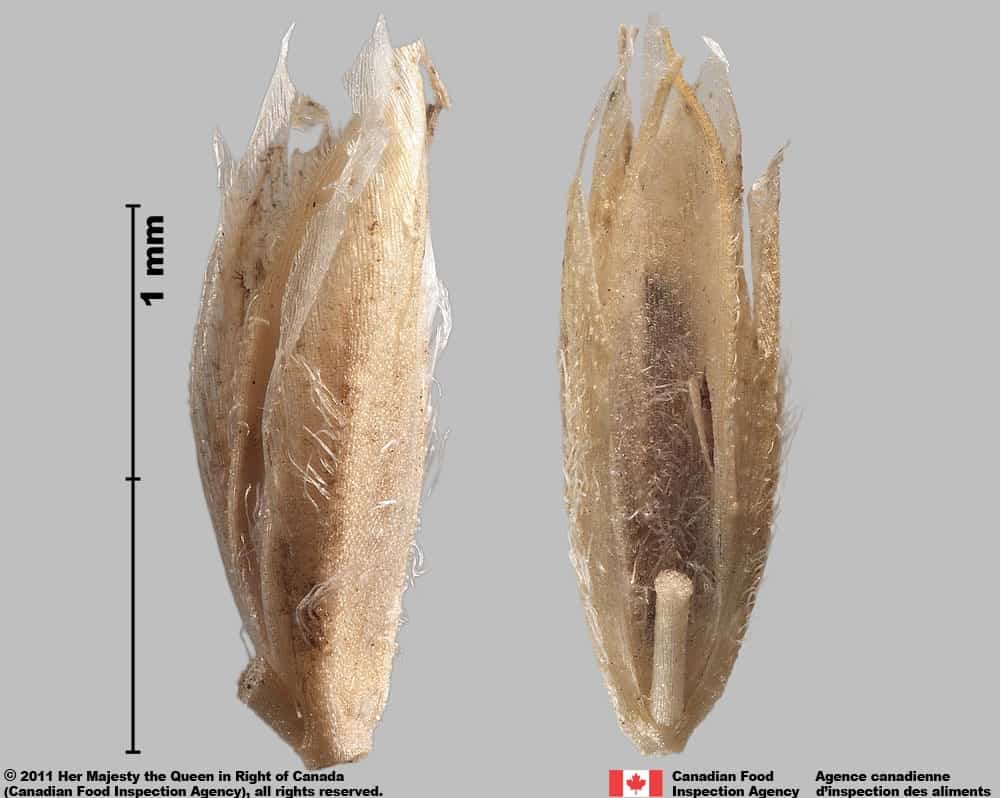
Poa alpina
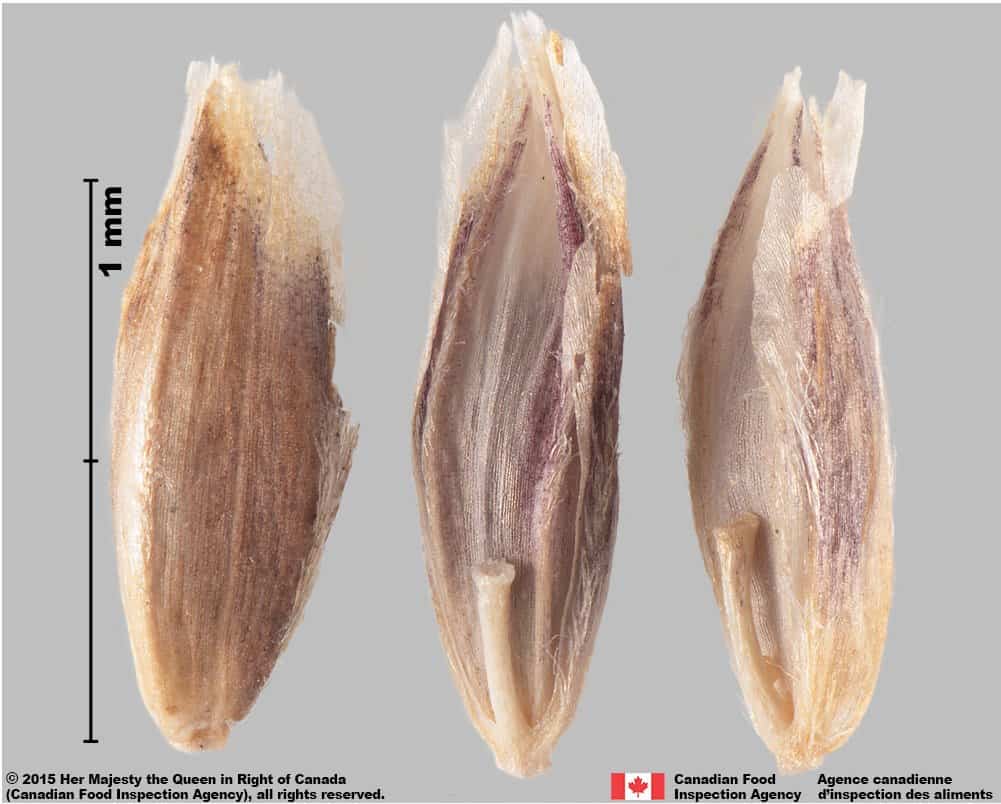
Poa supina
Comparison Window
Fenêtre de comparaison
MAIN SPECIES
ESPÈCES PRINCIPALES
Poa annua

Poa annua
Poaceae
Annual bluegrass (Poa annua) florets
MAIN SPECIES
ESPÈCES PRINCIPALES
Poa annua

Poa annua
Poaceae
Annual bluegrass (Poa annua) floret, palea view
MAIN SPECIES
ESPÈCES PRINCIPALES
Poa annua

Poa annua
Poaceae
Annual bluegrass (Poa annua) floret, palea view
MAIN SPECIES
ESPÈCES PRINCIPALES
Poa annua

Poa annua
Poaceae
Annual bluegrass (Poa annua) floret, palea close-up view
SIMILAR SPECIES
ESPÈCES SEMBLABLES
Poa alpina

Poa alpina
Poaceae
Alpine bluegrass (Poa alpina) florets; side view (L) and palea view (R)
SIMILAR SPECIES
ESPÈCES SEMBLABLES
Poa alpina
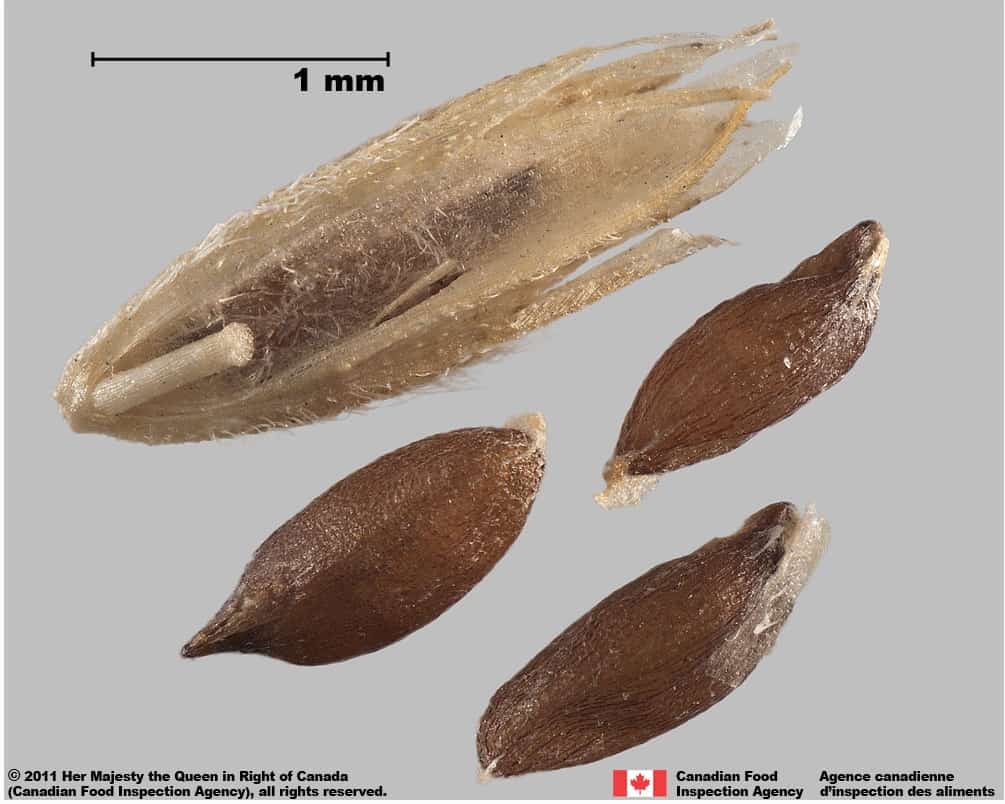
Poa alpina
Poaceae
Alpine bluegrass (Poa alpina) floret and caryopses
SIMILAR SPECIES
ESPÈCES SEMBLABLES
Poa alpina
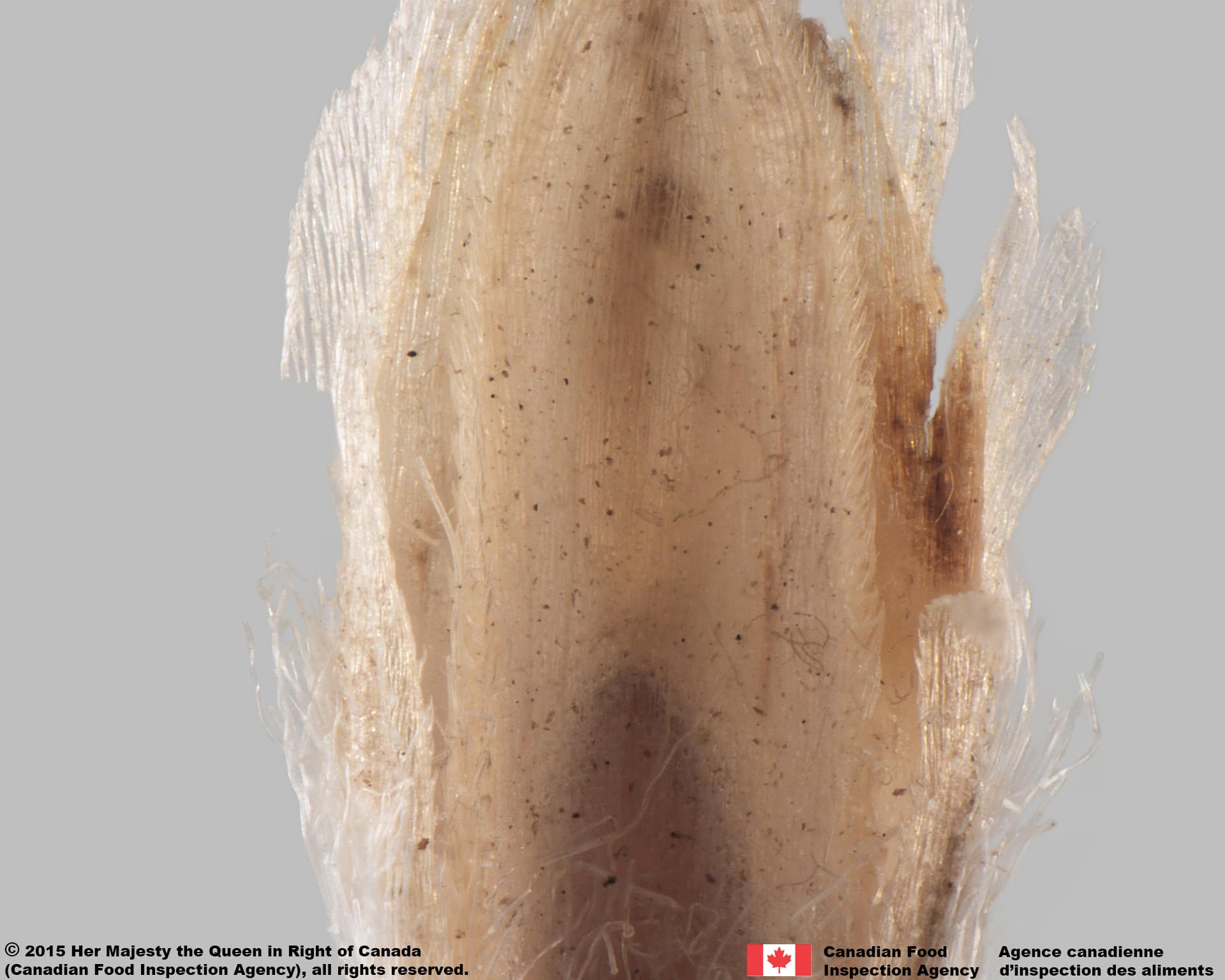
Poa alpina
Poaceae
Alpine bluegrass (Poa alpina) floret; palea close-up view
SIMILAR SPECIES
ESPÈCES SEMBLABLES
Poa alpina
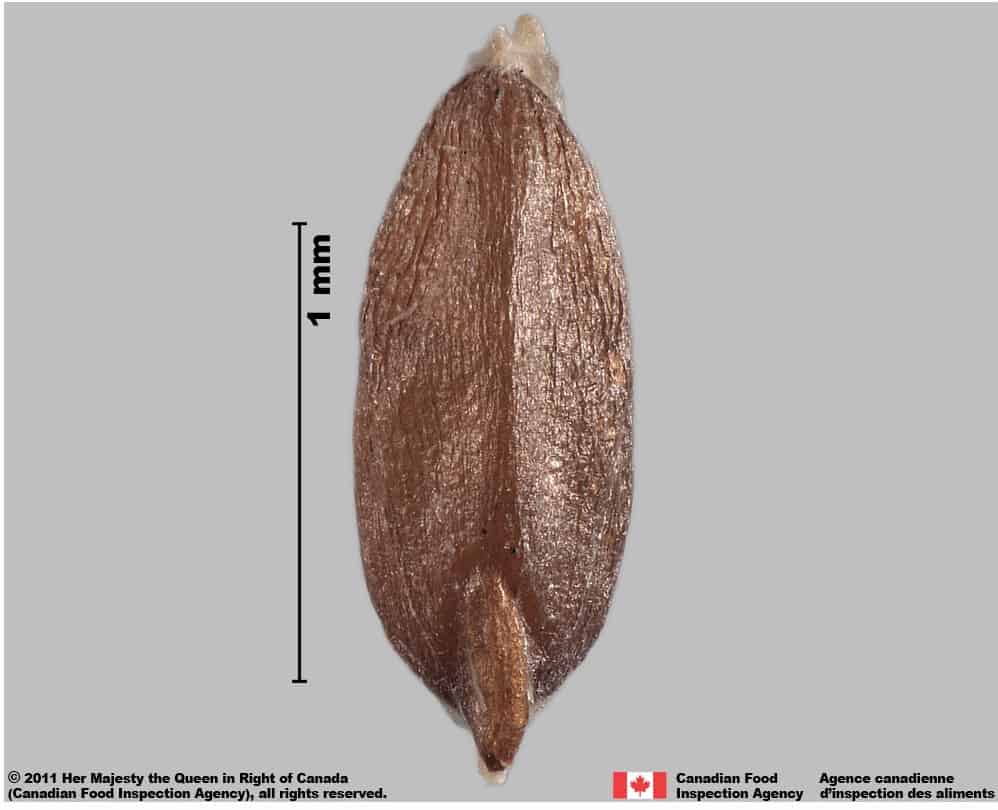
Poa alpina
Poaceae
Alpine bluegrass (Poa alpina) caryopsis
Need ID Help?
Besoin d’aide pour l’identification?
Reference(s)
Référence(s)
Alderson, J. and Sharp, W. C. 1995. Grass varieties in the United States, United States Department of Agriculture Handbook 170, rev. ed. CRC Press.
Association of Official Seed Analysts (AOSA). 2022. Rules for Testing Seeds, Vol. 1: Principles and Procedures. Association of Official Seed Analysts, Washington D. C.
Australian Plant Name Index (APNI). 2022. Vascular Plants, Poa annua. https://biodiversity.org.au/nsl/services/search/names?product=APNI&tree.id=&name=Poa+annua+L.&inc._scientific=&inc.scientific=on&inc._cultivar=&inc.cultivar=on&inc._other=&inc.other=on&max=100&display=&search=true Accessed December 16, 2022.
Barkworth, M. E., Capels, K. M., Long, S., and Piep, M. B. (eds.). 2007. Flora of North America Volume 24. Magnoliophyta: Commelinidae (in part): Poaceae, part 1. Oxford University Press, New York, New York.
Bojňanský, V. and Fargašová, A. 2007. Atlas of Seeds and Fruits of Central and East-European Flora: The Carpathian Mountains Region. Springer, Dordrecht, The Netherlands.
Center for Agriculture and Bioscience International (CABI). 2022. Poa annua (annual meadowgrass) – Datasheet. CABI – Invasive Species Compendium. https://www.cabi.org/isc/datasheet/42485. Accessed December 15, 2022.
Canadian Food Inspection Agency (CFIA). 2023. Canadian Methods and Procedures for Testing Seeds (M&P). Version 1.1, English. Canadian Food Inspection Agency.
DiTomaso, J. M. and Healy, E. A. 2007. Weeds of California and Other Western States. Vol. 2: Geraniaceae – Zygophyllaceae. Agriculture and Natural Resources Publication 3488. University of California, Oakland, CA.
Edgar, E. and Connor, H. E. 2000. Flora of New Zealand. Vol. V. Gramineae. Manaaki Whenua Press. Lincoln, NZ.
eFloras. 2022. Flora of China. Poa annua. efloras.org Accessed December 15, 2022.
Holm, L., Doll, J., Holm, E., Pancho, J. and Herberger, J. 1997. World Weeds: Natural Histories and Distribution. John Wiley & Sons Inc., New York, 1129 pp.
International Seed Morphology Association (ISMA). 2020. Method for seed size measurement. Version 1.0. ISMA Publication Guide. https://www.idseed.org/authors/details/method_for_seed_size_measurement.html.
International Seed Testing Association (ISTA). 2023. International Rules for Seed Testing. International Seed Testing Association. Bassersdorf, Switzerland. https://doi.org/10.15258/istarules.2022.F
Martin, A. C. 1946. The comparative internal morphology of seeds. The American Midland Naturalist 36(3):513-660.
Mitich, L. W. 1998. Annual Bluegrass (Poa annua L.). Weed Technology 1998 (12): pp. 414-416. https://www.cambridge.org/core/services/aop-cambridge-core/content/view/AA0F791AA408FB10F14A67B8A52A60DF/S0890037X00044031a.pdf/annual-bluegrass-poa-annua-l.pdf.
Molina-Montenegro, M. A., Bergstrom, D.M., Chwedorzewska, K. J., Convey, P., Chown, S. L. 2019. Increasing impacts by Antarctica’s most widespread invasive plant species as result of direct competition with native vascular plants. NeoBiota 51: 19–40. https://doi.org/10.3897/neobiota.@@.37250.
Musil, A. F. 1963. Identification of Crop and Weed Seeds. Agriculture Handbook No. 219. U. S. Department of Agriculture. Washington, D.C.
Nicoludis, Z. 2021. The ins and outs of managing Poa annua putting greens. https://www.usga.org/content/usga/home-page/course-care/green-section-record/59/10/the-ins-and-outs-of-managing-poa-annua-putting-greens.html Accessed December 19, 2022.
Pacific Island Ecosystems at Risk (PIER). 2017. Poa annua L., Poaceae. http://www.hear.org/pier/species/poa_annua.htm. Accessed December 19, 2022.
Royal Botanic Gardens KEW (KEW). 2023. Plants of the World Online: Poa alpina. https://powo.science.kew.org/taxon/urn:lsid:ipni.org:names:320036-2#source-KBD Accessed August 8, 2023.
Terrell, E. E. 1971. Survey of occurrences of liquid or soft endosperm in grass genera. Bull. Torr. Botan. Club 98(5):264-268.
United States Department of Agriculture-Agricultural Marketing Service (USDA-AMS). 2022a. Federal Seed Act Regulations. https://www.ecfr.gov/current/title-7/subtitle-B/chapter-I/subchapter-K/part-201 Accessed November 10, 2022.
United States Department of Agriculture-Agricultural Marketing Service (USDA-AMS). 2022b. State Noxious-Weed Seed Requirements Recognized in the Administration of the Federal Seed Act. https://www.ams.usda.gov/sites/default/files/media/StateNoxious WeedsSeedList.pdf Accessed December 19, 2022.
United States Department of Agriculture-Agricultural Research Service, National Plant Germplasm System (USDA-ARS). 2022. Germplasm Resources Information Network (GRIN Taxonomy). National Germplasm Resources Laboratory, Beltsville, Maryland. URL: https://npgsweb.ars-grin.gov/gringlobal/taxon/taxonomydetail?id=28904 Accessed December 15, 2022.
United States Department of Agriculture-Phytosanitary Certificate Issuance and Tracking System-Phytosanitary Export Database (USDA-PCIT-PExD). 2022. Phytosanitary import requirements of U.S.-origin commodities to foreign countries. https://pcit.aphis.usda.gov/PExD/faces/ViewPExD.jsf Accessed December 19, 2022.
Wiersema, J. H. and León, B. 1999. World Economic Plants: A Standard Reference. CRC Press, Boca Raton, FL.



